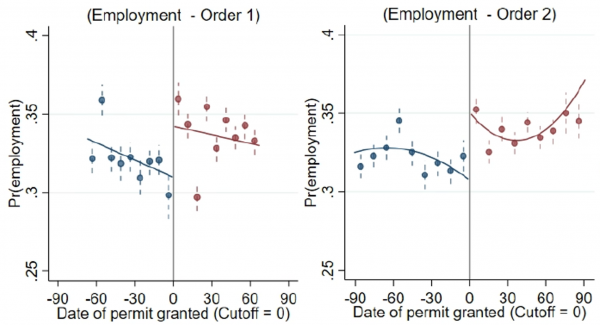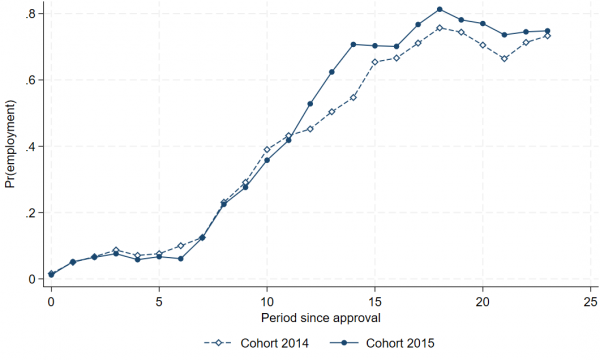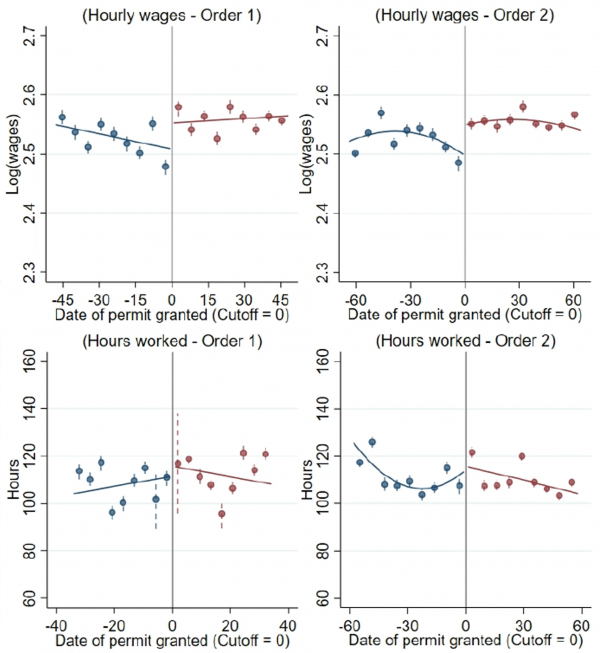We find a labour training programme significantly accelerates refugee employment and raises wages. With over 13 million refugees in Europe by the end of 2023, ensuring effective economic integration is a critical policy challenge. In response to persistently poor labour market outcomes among refugees, the Netherlands introduced a practical labour market training module (ONA) in 2015, supplementing its existing civic integration program. This study shows that the ONA significantly accelerates refugees’ employment, raises their wages, and improves the quality of firms they join. It suggests practical, job-oriented integration measures can enhance individual outcomes and broader labour market efficiency.
Economic refugee integration
The successful integration of refugees is vital to minimise welfare dependency and avoid economic and social segregation. However, refugees’ labour market outcomes substantially lag behind native and other types of immigrant workers in Europe (Fasani et al., 2022). To facilitate smooth entry into the labour market, European governments provide a range of active labour market programmes for refugees, including local language training (e.g., Germany, France) and Job Search Assistance (e.g., the UK).
The Dutch government introduced the Job Search Assistance programme, i.e., labour market training (ONA), as a part of their civic integration programme in January 2015. It aims to improve understanding of the Dutch labour market with a special focus on job search through researching available jobs and required skills and qualifications, and preparing a CV and mock job interview. Refugees who gained asylum after the introduction date were obliged to take the ONA, whilst those approved earlier were not.
What we do
We examine whether participation in the ONA improves refugees’ economic integration and affects the types of firms they enter. Leveraging a clear programme introduction in 2015 and detailed administrative data from 2014–2021, we compare labour market outcomes and firm quality between refugees who were obliged to take the ONA (treatment) and those who were not (untreated).
Training helps secure a job with higher wages
Our analysis reveals that the ONA boosts refugee employment probability by 3.0-4.3 percentage points (9-13%) over the six years after obtaining asylum status (Figure 1). Refugees who were granted asylum right before and right after the introduction date (1 January 2015) are similar to each other in many aspects: gender balance, country of origin composition, age, family structure, and other observable characteristics. Given this, and that they did not themselves choose whether or not to undertake the training, we can be assured that differences in employment can be attributed to ONA participation.
We also observe that the ONA speeds up entering the labour market. The employment rate among those who took the ONA reached 50% three years after approval, while those who did not took an additional three months to reach 50% (Figure 2).
Also, our study finds that those who passed the ONA found their first job approximately 2.1 months faster than those who didn’t take the ONA. This implies that the ONA reduces job search duration through CV preparation, interview practice and familiarisation with the job search process.
Figure 3 suggests the ONA has a positive impact on wages (1.7-2.1% higher hourly wages) but little difference in hours worked. In other words, the ONA helps to improve job quality (wages), but not quantity (hours).

Figure 1 ONA impacts on employment
Note Order 1 refers to a linear trend line, while Order 2 includes a curved trend line to capture non-linear patterns around the cut-off.

Figure 2 Trajectories of employment probability of Cohort 2015 (took ONA) and Cohort 2014 (no ONA)

Figure 3 ONA impacts on wages and hours worked, conditional on being employed
Note Order 1 refers to a linear trend line, while Order 2 includes a curved trend line to capture non-linear patterns around the cut-off.
ONA and firm qualities
We find the ONA helps refugees not only to enter the labour market, but also to get better-paid jobs, but does this mean they work for different types of firms? To answer this question, we also explore if the ONA helps refugees to get jobs at larger and productive firms. We find that the ONA leads to a higher probability of working at high value-added (i.e. larger) firms by 6-7 percentage points, and at firms with higher productivity by approximately 2.6-2.9 percentage points. This likely stems from that fact that the ONA leads to a better understanding of the Dutch labour market, including the available jobs and required skills/qualifications, thereby ensuring refugees find ‘better matching’ jobs.
Policy implications
Our study suggests that the ONA, a practical Job Search Assistance programme in the Netherlands, speeds up refugees’ entry into the labour market, and secures jobs with higher pay and at larger and highly productive firms. However, it does not contribute to longer hours worked. This is consistent with the fact that Job Search Assistance prioritises escaping from unemployment and sometimes overlooks improving general human capital, such as local language proficiency and specific occupational skills. However, even though the ONA boosts the employment and wages of refugees, they continue to lag behind other workers. This suggests that alongside the ONA, additional policy intervention is needed to improve refugees’ human capital.
About the author
Hiromi Yumoto is a Senior Research Officer at the University of Essex, and an Honorary Research Fellow at the University of Birmingham. hy23862@essex.ac.uk
Further information
Read more at: Cole, M.A., Jabbour, L., Ozgen, C., Yumoto, H. (2024). Refugees’ Economic Integration and Firms. Institute of Labour Economics IZA Discussion Paper No. 16828. Available at: https://www.iza.org/publications/dp/16828/refugees-economic-integration-and-firms.
References
- Fasani, F., Frattini T., and Minale L. (2022). ‘(The bstruggle for) refugee integration into the labour market: Evidence from Europe’. Journal of Economic Geography 22(2),351-393.
© MiSoC June 2025
DOI: 10.5526/misoc-2025-007
